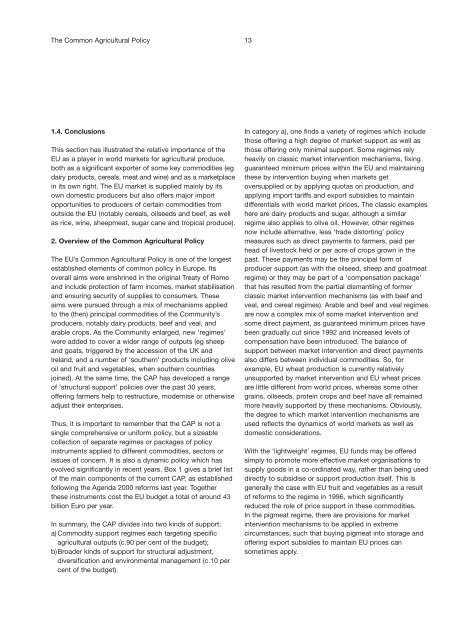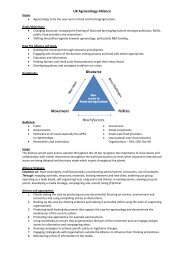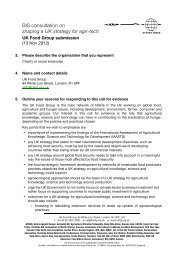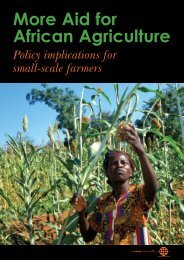Common Agricultural Policy - UK Food Group
Common Agricultural Policy - UK Food Group
Common Agricultural Policy - UK Food Group
Create successful ePaper yourself
Turn your PDF publications into a flip-book with our unique Google optimized e-Paper software.
The <strong>Common</strong> <strong>Agricultural</strong> <strong>Policy</strong> 13<br />
1.4. Conclusions<br />
This section has illustrated the relative importance of the<br />
EU as a player in world markets for agricultural produce,<br />
both as a significant exporter of some key commodities (eg<br />
dairy products, cereals, meat and wine) and as a marketplace<br />
in its own right. The EU market is supplied mainly by its<br />
own domestic producers but also offers major import<br />
opportunities to producers of certain commodities from<br />
outside the EU (notably cereals, oilseeds and beef, as well<br />
as rice, wine, sheepmeat, sugar cane and tropical produce).<br />
2. Overview of the <strong>Common</strong> <strong>Agricultural</strong> <strong>Policy</strong><br />
The EU’s <strong>Common</strong> <strong>Agricultural</strong> <strong>Policy</strong> is one of the longest<br />
established elements of common policy in Europe. Its<br />
overall aims were enshrined in the original Treaty of Rome<br />
and include protection of farm incomes, market stabilisation<br />
and ensuring security of supplies to consumers. These<br />
aims were pursued through a mix of mechanisms applied<br />
to the (then) principal commodities of the Community’s<br />
producers, notably dairy products, beef and veal, and<br />
arable crops. As the Community enlarged, new ‘regimes’<br />
were added to cover a wider range of outputs (eg sheep<br />
and goats, triggered by the accession of the <strong>UK</strong> and<br />
Ireland, and a number of ‘southern’ products including olive<br />
oil and fruit and vegetables, when southern countries<br />
joined). At the same time, the CAP has developed a range<br />
of ‘structural support’ policies over the past 30 years,<br />
offering farmers help to restructure, modernise or otherwise<br />
adjust their enterprises.<br />
Thus, it is important to remember that the CAP is not a<br />
single comprehensive or uniform policy, but a sizeable<br />
collection of separate regimes or packages of policy<br />
instruments applied to different commodities, sectors or<br />
issues of concern. It is also a dynamic policy which has<br />
evolved significantly in recent years. Box 1 gives a brief list<br />
of the main components of the current CAP, as established<br />
following the Agenda 2000 reforms last year. Together<br />
these instruments cost the EU budget a total of around 43<br />
billion Euro per year.<br />
In summary, the CAP divides into two kinds of support:<br />
a) Commodity support regimes each targeting specific<br />
agricultural outputs (c.90 per cent of the budget);<br />
b)Broader kinds of support for structural adjustment,<br />
diversification and environmental management (c.10 per<br />
cent of the budget).<br />
In category a), one finds a variety of regimes which include<br />
those offering a high degree of market support as well as<br />
those offering only minimal support. Some regimes rely<br />
heavily on classic market intervention mechanisms, fixing<br />
guaranteed minimum prices within the EU and maintaining<br />
these by intervention buying when markets get<br />
oversupplied or by applying quotas on production, and<br />
applying import tariffs and export subsidies to maintain<br />
differentials with world market prices. The classic examples<br />
here are dairy products and sugar, although a similar<br />
regime also applies to olive oil. However, other regimes<br />
now include alternative, less ‘trade distorting’ policy<br />
measures such as direct payments to farmers, paid per<br />
head of livestock held or per acre of crops grown in the<br />
past. These payments may be the principal form of<br />
producer support (as with the oilseed, sheep and goatmeat<br />
regime) or they may be part of a ‘compensation package’<br />
that has resulted from the partial dismantling of former<br />
classic market intervention mechanisms (as with beef and<br />
veal, and cereal regimes). Arable and beef and veal regimes<br />
are now a complex mix of some market intervention and<br />
some direct payment, as guaranteed minimum prices have<br />
been gradually cut since 1992 and increased levels of<br />
compensation have been introduced. The balance of<br />
support between market intervention and direct payments<br />
also differs between individual commodities. So, for<br />
example, EU wheat production is currently relatively<br />
unsupported by market intervention and EU wheat prices<br />
are little different from world prices, whereas some other<br />
grains, oilseeds, protein crops and beef have all remained<br />
more heavily supported by these mechanisms. Obviously,<br />
the degree to which market intervention mechanisms are<br />
used reflects the dynamics of world markets as well as<br />
domestic considerations.<br />
With the ‘lightweight’ regimes, EU funds may be offered<br />
simply to promote more effective market organisations to<br />
supply goods in a co-ordinated way, rather than being used<br />
directly to subsidise or support production itself. This is<br />
generally the case with EU fruit and vegetables as a result<br />
of reforms to the regime in 1996, which significantly<br />
reduced the role of price support in these commodities.<br />
In the pigmeat regime, there are provisions for market<br />
intervention mechanisms to be applied in extreme<br />
circumstances, such that buying pigmeat into storage and<br />
offering export subsidies to maintain EU prices can<br />
sometimes apply.





